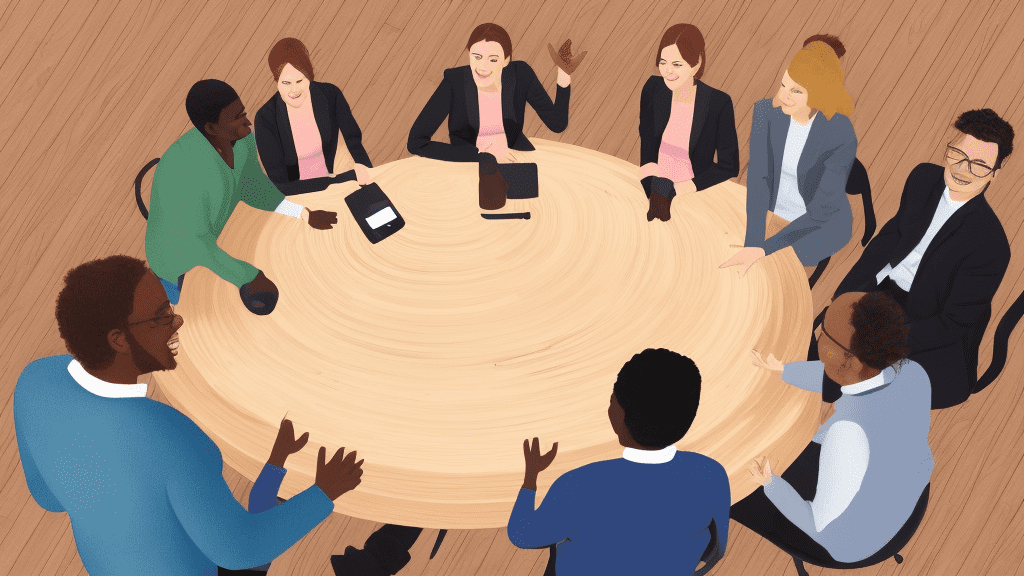We have conversations all the time, whether with friends, family, work colleagues, or ourselves.
Conversation is probably one of humanity’s oldest social technologies, possibly even older than campfires. And by social technology, I mean any solution used by a group of people to solve a social challenge or need.
It is a technology that can be used for leisure, for making decisions, transforming conflicts, triggering revolutions, manipulating someone, arguing, and even for putting someone to sleep.
Conversation is not software, it’s socialware. It’s probably the most popular social “app” in the world, reaching even places without electricity.
Seriously. Everyone loves to chat, right?
However, you’ve probably been in a conversation where everyone wanted to discuss a topic and, for some reason, they couldn’t. It seems like there’s a dispute to occupy the space of interaction.
My hypothesis is that this happens due to a large influence of explicit, hidden, and invisible power structures in social relationships that privilege certain individuals more than others in conversations and interactions of all kinds. This concentration of power contributes to a structural conflict in communication between people, organizations, and even countries.
In other words, the emotional bag of the situation gets full, and the drama starts to appear.
If there is no explicit and consensual agreement on how interactions should happen, those who concentrate more power will have a better chance of dominating the space.
When I say power, I am referring to characteristics such as race, gender, economic factors, position, eloquence, education, and a series of other things that some people have and others do not.
When acting as an organizational designer, I always seek to design artifacts that will favor the emancipation of relationships by limiting the possibility of subordination between people as much as possible.
Power is something natural and essential for the functioning of society, but when it is exercised over the other it is oppression, and this oppression can happen in very subtle and even unintentional ways.
That passive-aggressive friend who dominates the meeting often isn’t even aware that they act that way.
I assume that people who abuse power should be held accountable for it, but I also recognize that certain social structures encourage certain abusive behaviors. If these structures are not dissolved, this behavior will continue to manifest.
All of this is to say that the structure of the conversation, whether intentionally designed or not, will shape people’s interaction in the group and influence the quality of the chat, ideas, decisions, plans, and the quality of relationships.
Now, any organization is the product of conversations that took place to explore, decide, plan, and execute things.
The problem is that these conversations are often one-sided and prioritize the interests of a small portion of the people participating.
We need emancipatory structures for generative conversations that add meaning to our experience. Enough of meetings that could be an email and elevator talk!
Who has never been in a meeting where people interrupt each other all the time and the subject suddenly changes? Who has never felt nauseous watching a presidential debate? Who hasn’t?
That’s right. These conversations suffer from the tyranny of lack of structure, which ends up favoring an implicit structure, and the situation often becomes a win-lose game.
So how can we design conversations that offer generative spaces to explore, decide, plan, and care for relationships?
How can we offer a balanced space for participation where everyone can express themselves in a conversation if they want to?
We do this by changing the way people interact, that is, with structural interventions.
Two basic modes of conversation in groups

A group conversation can happen in two basic ways: popcorn mode or round mode.
Popcorn Mode: Anyone can speak at any time, there is no speaking order or any restriction.
Round Mode: Only one person can speak at a time, usually in an order or when invited to speak.
If anyone can speak at any time, there is a high chance that they will speak at the same time, which can stimulate a competition for territory in the interaction space.
Popcorn mode is generally useful so that people can ask questions to a single person who will answer. It is also useful when the intention is to let the conversation flow and structure itself more spontaneously, in a natural flow.
Round mode, on the other hand, can be used every time you want to offer a space where everyone has a chance to speak if they want to.
Round mode is usually hosted by someone who will invite people to express themselves, one at a time.
The invitation can be replaced by a “talking stick,” which is basically any object agreed upon by the group to indicate that the person holding the object can speak without interruptions.
In this way, we respect two basic principles of generative conversations:
1. Only one person speaks at a time.
2. Everyone should have the right to occupy speaking space and the possibility of exercising that right without fear.
Intentional Rounds
Rounds are extremely versatile for exploring varied topics with different perspectives. You can define an intention for the round and gather a lot of cool things. Here are some examples of round framing.
Reaction: rounds of reactions on proposals where people can express themselves freely about what is being proposed.
Optimism: rounds where people can only express themselves optimistically about something.
Pessimism: rounds where people can only express themselves critically, investigating what could go wrong with an idea.
Feeling: rounds where each person shares how they feel emotionally about a certain topic.
Creative: rounds where people are invited to generate ideas about a certain topic.
By using the round with a pre-defined intention, it is possible to invite everyone to look at a topic from the same perspective, avoiding discussions between people who are using different lenses.
People who would not normally use some of these lenses are also invited to look at some topics with another perspective.
These are just some ways that show how conversations can take on different contours when designing an intentional, explicit, and consensual structure.
Bringing Rounds to Your Conversations
You can start practicing rounds right now. Here are some practical ideas to do this.
Situation #1: You do not have the authority to change the structure of conversations and would like to explore some way anyway.
In this case, you can propose an agreement and obtain people’s consent.
Here is an example of an agreement that can be proposed: “Every time someone wants to give the possibility for everyone present to express themselves about something, just announce that they would like to do a round.”
You can also simply propose a round without any agreement and see what happens.
Situation #2: You are a person in charge of facilitating a meeting or designing processes and rituals for the organization.
If you already have the authority to facilitate the meeting, just pay close attention to the moments when it might be interesting to propose a round. Usually, when someone brings a proposal that changes the organizational structure, that brings a new project or a crazy idea, it is interesting to use this artifact.
Writing an agreement like the one presented above can be a simple way to scale the artifact to various interaction spaces in the organization.
Recommendations When Using Rounds
Do not try to force the use of rounds. Ensure that people have consented to the use of the artifact.
Rounds with large groups (> 12 people) can take a long time. Consider breaking up the groups if necessary.
Doing too many rounds in a row can be boring. Popcorn mode is also important.
Not everyone needs to say something in a round. It’s okay to remain silent.
Designing Generative Interaction Spaces
Round mode is just one example of a structural intervention in social systems that can stimulate people’s participation in a more balanced way. It is quite powerful, but it is not a silver bullet.
Rounds will not solve the problem of psychological safety in your organization.
Power structures go far beyond the factors we have addressed here and need to be considered to design effective interventions in this regard.
It’s not just because you now have the possibility to offer a space for everyone to express themselves that people will occupy that space. Did you think it would be that easy? :P
Factors such as the chain of command, class struggle, and historical issues of the context greatly influence people’s willingness to express themselves. Not to mention the personal problems they have beyond work.
It is certain that conversation design is very relevant for intervening in cultural aspects that reinforce the culture of fear and the docile subordination of bodies to the division of labor. By inserting small changes in the structure of interactions between the individuals of an organization, we can observe large impacts on the flow of information, innovation processes, decision-making, and the psychological safety of people.
Using rounds and other conversation design approaches is like playing a collaborative game where the quality of communication wins.
Every time a group uses such an artifact, it gains 5 points of mutual understanding and 10 points of representativeness.
But it is not enough on its own to transform the relations of subordination in organizations. It’s okay, right? You can’t have everything at once.
There are several social technologies that can help in conversation design. Here are some of them so you can research and gain more vocabulary in this field:
- Liberating Structures
- World Café
- Conversation Café
- Open Space Technology
- Art of Hosting
- Six Thinking Hats
- Lean Coffee
This pamphlet is an invitation for you to also act as a conversation designer, who goes around experimenting with changes in social structures in order to stimulate the emancipation of relationships.
Thank you for reading this far. :)



Leave A Comment